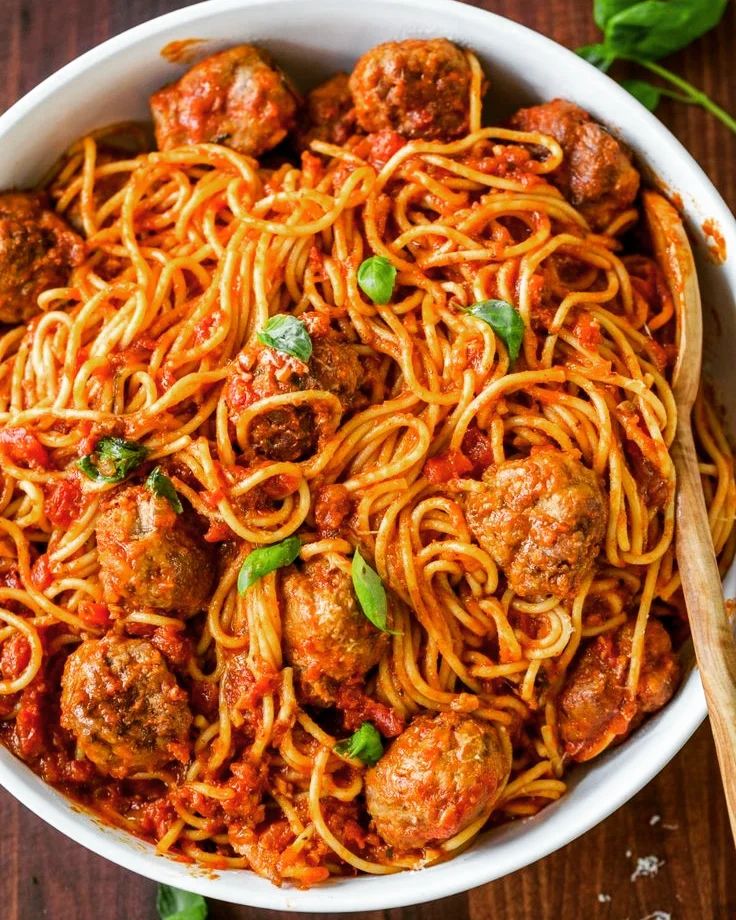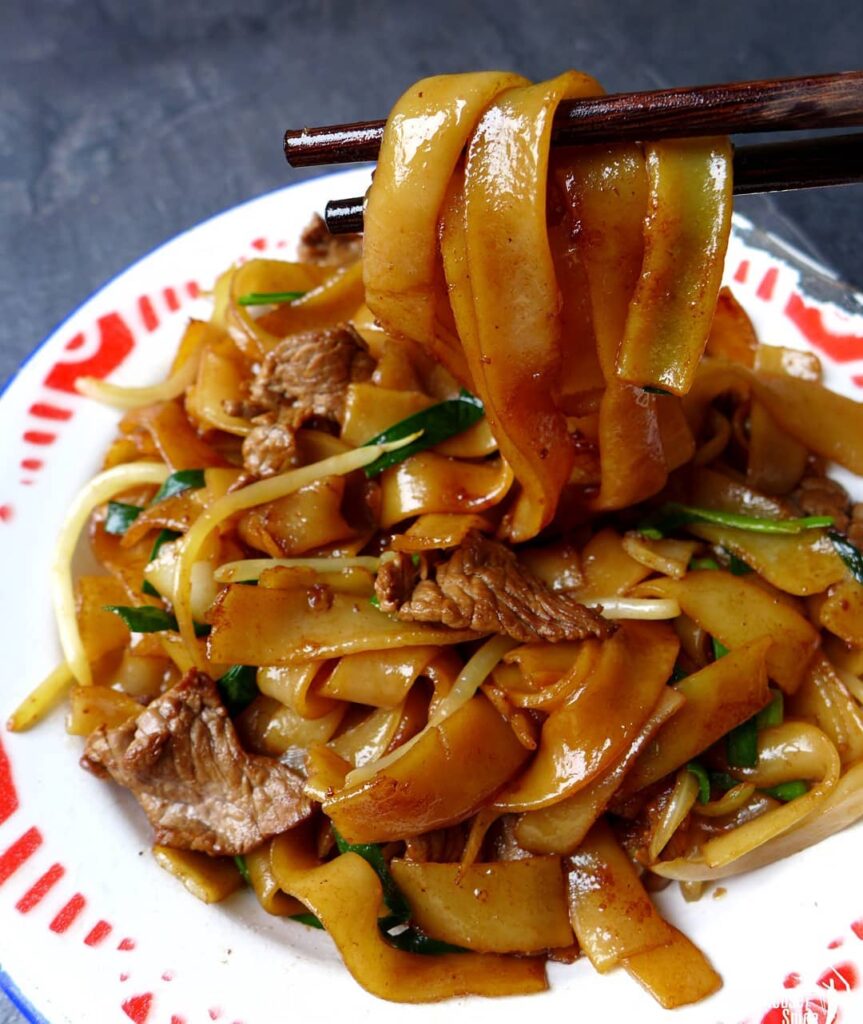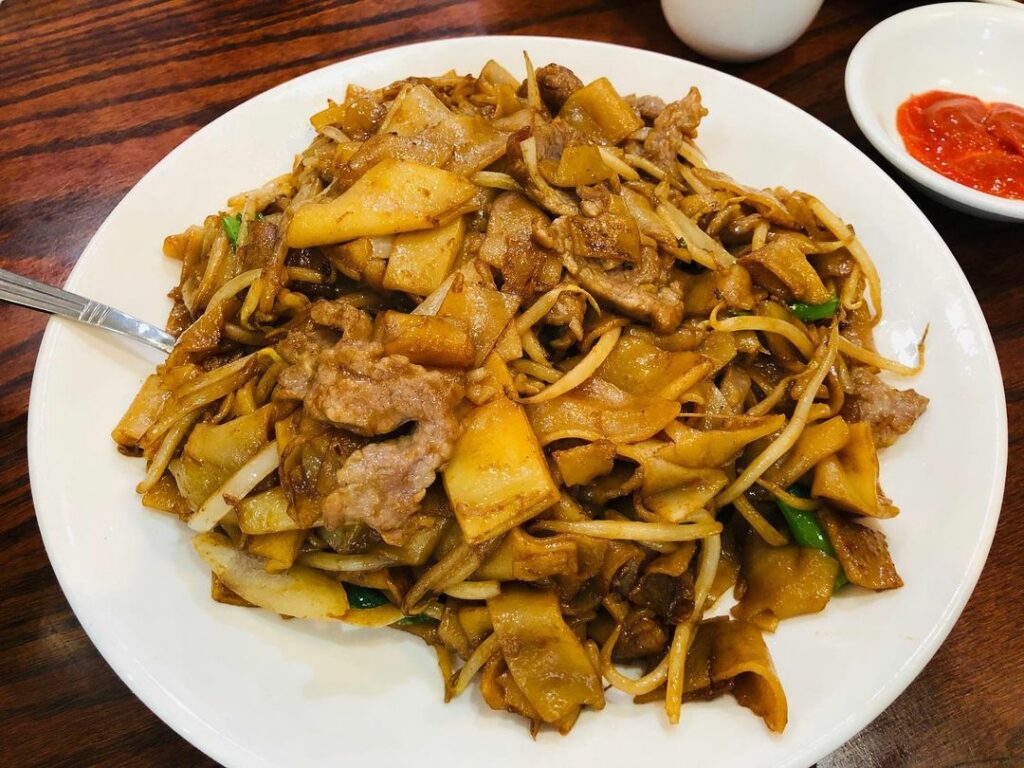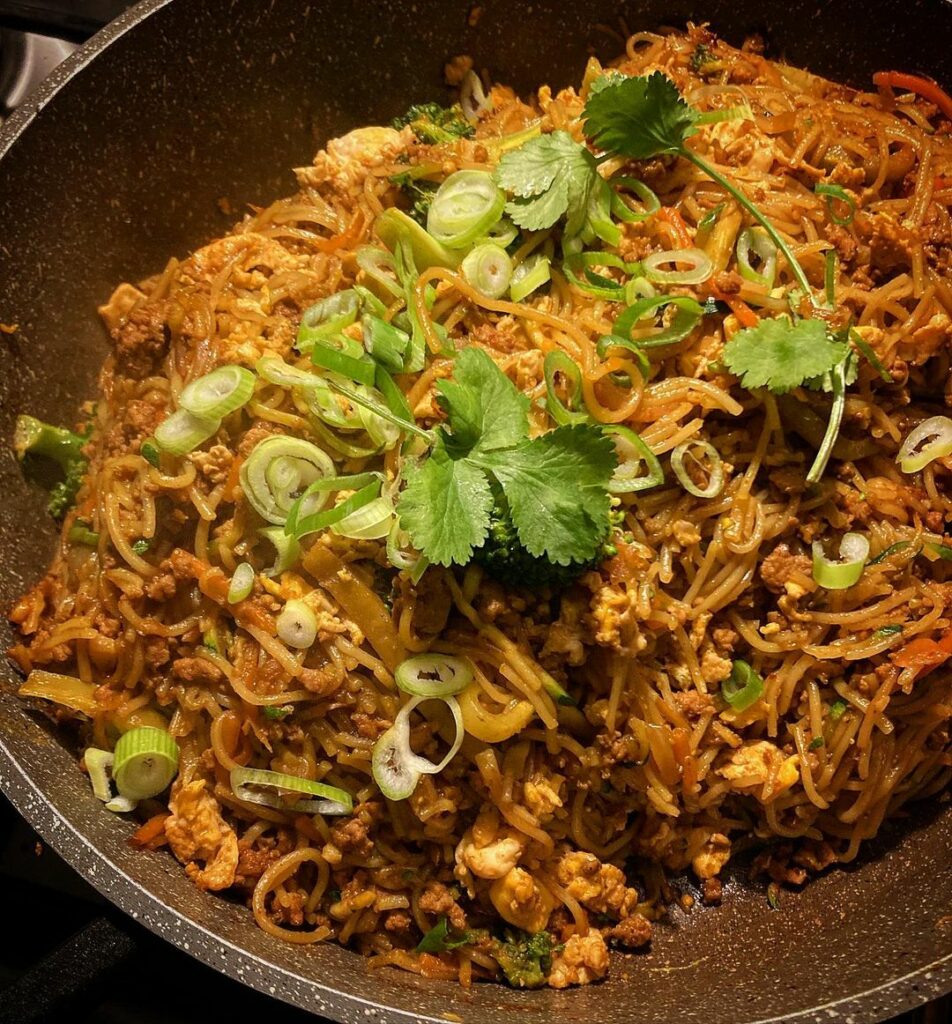Chinese cuisine has gained immense popularity worldwide, and its diverse noodle dishes are a significant highlight. In this article, we delve into the intriguing comparison between two beloved Chinese noodle dishes: Chow Fun vs Mei Fun. We will explore their unique characteristics, including taste, texture, and cooking methods.
Additionally, we will examine their nutritional profiles and discuss the health benefits of each. By the end, you’ll have a comprehensive understanding of the differences between Chow Fun and Mei Fun, enabling you to make informed choices when indulging in these delectable Chinese noodles.
What is chow fun vs mei fun?

Chow Fun and Mei Fun are two distinct Chinese noodle dishes, each with its own unique characteristics.
Chow Fun, also known as Ho Fun, is a Cantonese dish featuring wide, flat rice noodles. It originated in southern China and is commonly associated with Cantonese cuisine. The name “Chow Fun” translates to “fried rice noodles,” highlighting its stir-frying cooking method.
On the other hand, Mei Fun, also referred to as Mifen or Mai Fun, consists of thin rice noodles. It has its roots in southern China as well but is more closely associated with Fujian and Taiwanese cuisines. The name “Mei Fun” translates to “rice vermicelli,” emphasizing the thinness of the noodles.
Both Chow Fun and Mei Fun have a rich historical background, reflecting the cultural heritage of the regions they originate from. These dishes have evolved over time, incorporating various regional ingredients, flavors, and cooking techniques, making them beloved staples in Chinese cuisine.
What is the difference between chow fun and mei fun?

Chow Fun and Mei Fun, while both rice noodle dishes, differ in several aspects:
Chow Fun Noodles
- Chow Fun noodles are wide and flat, giving them a substantial texture.
- They have a slightly chewy and tender consistency.
- Common ingredients in Chow Fun include beef, chicken chow fun, shrimp chow fun, and vegetables like bean sprouts and green onions.
- Regional variations of Chow Fun include the popular Beef Chow Fun from Cantonese cuisine and the Char Kway Teow from Malaysian and Singaporean cuisine.
Mei Fun Noodles
- Mei Fun noodles are thin and delicate, providing a lighter mouthfeel.
- They are often softer and more pliable compared to Chow Fun noodles.
- Mei Fun dishes commonly incorporate ingredients like chicken mei fun, pork, shrimp mei fun, tofu, and a variety of vegetable mei fun.
- Regional variations of Mei Fun include the Taiwanese-style Mei Fun with soy sauce and the Fujian-style Mei Fun with seafood and mushrooms.
Differences in Cooking Methods:
- Chow Fun is typically stir-fried, where the wide noodles are cooked over high heat with other ingredients.
- Stir-frying Chow Fun helps achieve a smoky flavor and slightly crispy texture.
- Mei Fun can also be stir-fried, but it is commonly boiled or soaked in hot water to soften the delicate noodles before being added to stir-fried dishes.
- Stir-frying Mei Fun quickly heats the thin noodles while retaining their tenderness.
These differences in noodle thickness, texture, ingredient variations, and cooking methods contribute to distinct flavor profiles and overall dining experiences when enjoying Chow Fun and Mei Fun dishes.
Is chow fun vs mei fun healthy?

Both Chow Fun and Mei Fun can be part of a healthy diet when prepared and consumed mindfully. Here are the health benefits associated with each:
Health Benefits of Chow Fun
- Chow Fun noodles, made from rice, are high in carbohydrates, providing energy for the body.
- They also contain dietary fiber, aiding in digestion and promoting a healthy gut.
- Chow Fun dishes often incorporate vegetables, such as bean sprouts and green onions, adding essential vitamins and minerals to the meal.
- For individuals with specific dietary needs, Chow Fun can be a suitable option as it is typically gluten-free.
Health Benefits of Mei Fun
- Mei Fun noodles, like Chow Fun, are made from rice and are low in fat and calories.
- They are a suitable choice for those looking for a lighter, lower-calorie noodle option.
- Mei Fun is naturally gluten-free, making it an excellent alternative for individuals with gluten intolerance or sensitivity.
- The potential health benefits of Mei Fun come from the nutrients in the accompanying ingredients, such as lean proteins like shrimp or tofu and a variety of vegetables.
Considerations for Healthier Options
- To enhance the nutritional value of Chow Fun and Mei Fun dishes, consider adding a variety of vegetables. This increases the fiber content and provides additional vitamins and minerals.
- Using lean proteins like grilled chicken or tofu instead of higher-fat options can make the dish healthier.
- Reducing the amount of sodium and oil used in the cooking process helps promote a healthier overall meal.
- Portion control is essential for maintaining a balanced diet, so be mindful of serving sizes when enjoying Chow Fun or Mei Fun.
What is taste and flavor of chow fun vs mei fun?
- Chow Fun: Slightly chewy and soft texture. The flavor is often savory and rich, with a balance of soy sauce, garlic, and other seasonings.
- Mei Fun: Made with thin rice noodles, they are delicate, thin, and often translucent when cooked. The flavor profile of Mei Fun is typically lighter and more refreshing.
While both Chow Fun and Mei Fun are delicious noodle dishes, they offer distinct tastes and textures due to their different noodle varieties and seasoning choices. The choice between them often comes down to personal preference for thicker or thinner noodles and the specific flavors one desires.
What to serve with chow fun vs mei fun?

When serving Chow Fun or Mei Fun noodles and vegetable Chow Fun vs Mei Fun
there are various accompaniments that can complement the dish. Here are some popular options:
Chow Fun
- Stir-fried vegetables: Bok choy, broccoli, bell peppers, or Chinese broccoli are common choices.
- Protein options: Sliced beef, chicken, shrimp, or tofu can be served alongside Chow Fun.
- Soy sauce or chili sauce: These condiments can be offered as additional flavor enhancers.
- Chinese pickles: Pickled radishes or cucumbers can provide a tangy contrast to the savory Chow Fun.
Mei Fun
- Stir-fried or steamed vegetables: Serve a side dish of vegetables like baby corn, snow peas, carrots, or cabbage.
- Steamed dumplings: Enjoy Mei Fun with steamed dumplings like potstickers or gyoza.
- Asian-style pickles: Pickled daikon radish, kimchi, or pickled vegetables can add a tangy kick to the meal.
- Light soups: A bowl of clear broth-based soup, such as hot and sour soup or egg drop soup, can be served alongside Mei Fun for a balanced meal.
How to store chow fun vs mei fun?
To store Chow Fun or Mei Fun properly, follow these guidelines:
Storing Chow Fun
- Leftover Chow Fun should be transferred to an airtight container.
- Refrigerate the container promptly, within 2 hours of cooking.
- Chow Fun can be stored in the refrigerator for up to 3-4 days.
- Before reheating, consider adding a small amount of water or broth to moisten the noodles and prevent them from drying out.
Storing Mei Fun
- Place any leftover Mei Fun in an airtight container.
- Refrigerate the container promptly, within 2 hours of cooking.
- Mei Fun can be stored in the refrigerator for up to 3-4 days.
- To prevent the noodles from sticking together, you can toss them with a small amount of oil before refrigerating.
Reheating both Chow Fun, and Mei Fun
- Reheat the noodles using a method that retains moisture, such as steaming or stir-frying in a small amount of oil.
- Avoid microwaving the noodles directly, as it may cause them to become dry and lose their texture.
- Add a little bit of water, broth, or sauce to the noodles while reheating to maintain their moisture and prevent them from sticking.
FAQs
Can Chow Fun or Mei Fun be considered a healthy option?
Both Chow Fun and Mei Fun can be part of a healthy diet when prepared and consumed mindfully. Chow Fun provides energy from carbohydrates and fiber, while Mei Fun is low in fat and calories. Adding vegetables, lean proteins, and controlling sodium and oil content can enhance their nutritional value.
Are Chow Fun noodles gluten-free?
Chow Fun noodles are typically made from rice, which is naturally gluten-free. However, it’s essential to check the specific brand or preparation method, as some manufacturers may add other ingredients that could contain gluten. When in doubt, look for noodles labeled as gluten-free.
What are some popular Chow Fun and Mei Fun dishes from different regions?
Some popular Chow Fun dishes include Cantonese Beef Chow Fun, Malaysian Char Kway Teow, and Thai Pad See Ew. Mei Fun variations include Taiwanese Soy Sauce Mei Fun, Fujian Seafood Mei Fun, and Singaporean/Malaysian Curry Mei Fun. Regional preferences and local ingredients influence the specific dishes available.
See more: How to Make Cantonese Chow Mein?
Are Chow Fun and Mei Fun spicy dishes?
The spiciness of Chow Fun and Mei Fun dishes can vary depending on the specific recipe and personal preference. While some versions may include spicy elements, it is not a defining characteristic of these dishes. Chow Fun and Mei Fun can be prepared with mild or non-spicy flavors as well.
In general, Chow Fun and Mei Fun are more known for their savory, umami-rich profiles rather than spiciness. However, it’s important to note that regional variations and personal adaptations can introduce different levels of heat and spiciness to these dishes.
If you prefer spicier flavors, you can add chili sauce, chili paste, or other spicy condiments to your Chow Fun or Mei Fun. Likewise, if you prefer milder flavors, you can adjust the amount of spicy ingredients or omit them altogether.
The spiciness of Chow Fun and Mei Fun can be customized according to personal taste preferences. It’s best to communicate your spice preference when ordering at a restaurant or adjust the seasonings and ingredients to suit your desired level of heat when preparing these dishes at home.
Are there any specific sauces or seasonings associated with Chow Fun and Mei Fun?
Yes, there are specific sauces and seasonings commonly used in Chow Fun and Mei Fun dishes to enhance their flavors. While variations can exist, here are some typical sauces and seasonings associated with these dishes:
Chow Fun:
- Soy sauce: Adds savory umami flavors and a touch of saltiness.
- Oyster sauce: Provides richness and depth of flavor.
- Hoisin sauce: Adds sweetness and a hint of tanginess.
- Sesame oil: Imparts a nutty aroma and enhances the overall taste.
- Dark soy sauce: Offers a deeper color and richer flavor.
Mei Fun:
- Soy sauce: Brings out the umami flavors and provides a savory base.
- Rice vinegar: Adds a mild tanginess and helps balance the flavors.
- Sesame oil: Enhances the aroma and lends a subtle nutty taste.
- Garlic: Provides a pungent kick and aromatic notes.
- Scallions: Adds a fresh and mild onion flavor.
Can Chow Fun and Mei Fun be made with whole-grain noodles for added nutritional benefits?
Yes, Chow Fun and Mei Fun can be made with whole-grain noodles as a healthier alternative, providing added nutritional benefits. Whole-grain noodles are made from whole grains, which retain the bran, germ, and endosperm, providing more fiber, vitamins, minerals, and antioxidants compared to refined white noodles.
By substituting traditional noodles with whole-grain noodles, you can increase fiber content and potentially improve digestive health. Whole grains also offer a slower release of energy, contributing to better blood sugar control and satiety.
When using whole-grain noodles for Chow Fun or Mei Fun, be mindful of the cooking time, as they may require slightly longer cooking compared to refined noodles. Additionally, the taste and texture of whole-grain noodles can be slightly different from traditional noodles, but they can still be delicious and satisfying.
Look for whole-grain noodle options available in stores or consider making your own homemade whole-grain noodles for an even healthier twist. Incorporating whole-grain noodles into Chow Fun and Mei Fun allows you to enjoy these dishes while reaping the nutritional benefits of whole grains.
Can Chow Fun and Mei Fun be made with fresh homemade noodles instead of store-bought noodles?
Yes, Chow Fun and Mei Fun can certainly be made with fresh homemade noodles instead of store-bought noodles. In fact, using fresh homemade noodles can elevate the flavor and texture of these dishes.
Making fresh homemade noodles allows for customization and control over the ingredients and thickness of the noodles. You can adjust the recipe to suit your preferences, whether it’s a traditional recipe or a personal adaptation.
To make fresh homemade noodles for Chow Fun or Mei Fun, you can combine flour, water, and sometimes other ingredients like salt or eggs to create a dough. The dough is then rolled out and cut into the desired noodle shape, such as wide flat noodles for Chow Fun or thin vermicelli-like noodles for Mei Fun.
Using fresh homemade noodles adds a distinct freshness and authenticity to the dishes, allowing you to tailor them to your liking. However, keep in mind that making fresh homemade noodles requires time and effort. If you prefer a quicker and more convenient option, store-bought noodles can still yield delicious results.
Are Chow Fun and Mei Fun suitable for individuals on a low-carb or keto diet?
Chow Fun and Mei Fun, as traditional rice noodle dishes, are not typically considered suitable for individuals following a strict low-carb or keto diet. Rice noodles are higher in carbohydrates compared to low-carb or keto-friendly alternatives.
However, if you are following a low-carb or keto diet, there are alternative noodle options available that can be used to create a similar experience. Options like zucchini noodles (zoodles) or shirataki noodles (made from konjac yam) are low in carbs and can be substituted for rice noodles in Chow Fun and Mei Fun recipes.
Can Chow Fun and Mei Fun be made with alternative noodle options, such as zucchini noodles or shirataki noodles?
When consumed in moderation as part of a balanced diet, Chow Fun and Mei Fun are generally considered healthy and safe for most individuals. However, there are a few health considerations to keep in mind:
- Calorie Content: Both Chow Fun and Mei Fun can be calorie-dense, especially if prepared with high-fat ingredients or excessive amounts of oil. It’s important to be mindful of portion sizes and consider the overall balance of your meal.
- Sodium Content: Some Chow Fun and Mei Fun dishes may contain sauces or seasonings that are high in sodium. Individuals with high blood pressure or those watching their sodium intake should be cautious and opt for reduced-sodium options or use condiments sparingly.
- Allergies and Intolerances: Chow Fun and Mei Fun dishes may contain common allergens such as soy, wheat, shellfish, or peanuts. If you have any known allergies or intolerances, it’s essential to check the ingredients and preparation methods to ensure they meet your dietary needs.
- Gluten Sensitivity: Traditional Chow Fun and Mei Fun are made with rice noodles, which are typically gluten-free. However, cross-contamination is possible, especially when eating at restaurants. Individuals with gluten sensitivity or celiac disease should be cautious and look for certified gluten-free options.
- Ingredient Choices: The healthiness of Chow Fun and Mei Fun depends on the ingredients used. Opting for lean proteins, plenty of vegetables, and moderation of sauces and oils can enhance the nutritional value of the dishes.
Are there any health concerns associated with consuming Chow Fun or Mei Fun?
Yes, Chow Fun and Mei Fun can be made with alternative noodle options, including zucchini noodles or shirataki noodles. These alternatives offer lower-carb and lower-calorie options compared to traditional rice noodles, making them suitable for individuals following specific dietary preferences or restrictions.
Zucchini noodles, often referred to as zoodles, can be used as a substitute for rice noodles in Chow Fun and Mei Fun dishes. Zucchini noodles are made by spiralizing zucchini into noodle-like shapes. They have a lighter texture and add a fresh, vegetable element to the dish.
Shirataki noodles, on the other hand, are translucent noodles made from konjac yam. They are extremely low in calories and carbohydrates, making them a popular choice for those on low-carb or keto diets. Shirataki noodles can be used as a substitute for rice noodles in Chow Fun and Mei Fun, providing a low-calorie and low-carb option.
When using alternative noodle options, it’s important to note that the taste, texture, and cooking time may differ from traditional noodles. However, they can still be a delicious and healthier alternative, allowing you to enjoy the flavors and concepts of Chow Fun and Mei Fun while adhering to specific dietary needs.
Conclusion
With this in mind, Chow Fun vs Mei Fun are two distinct Chinese noodle dishes, each with its own unique characteristics, flavors, and cultural significance. Chow Fun stands out with its wide, flat rice noodles, bold flavors, and stir-frying cooking method. On the other hand, Mei Fun features delicate thin rice noodles, a lighter taste profile, and various regional variations.
The taste and flavor of Chow Fun are characterized by savory, umami-rich profiles, often enhanced by soy sauce, oyster sauce, and smoky notes from stir-frying. Mei Fun, on the other hand, offers a lighter and fresher taste, with flavors brought out by soy sauce, rice vinegar, and subtle seasonings.
Whether you prefer the boldness of Chow Fun or the delicacy of Mei Fun, both dishes can be enjoyed with a variety of accompaniments, such as stir-fried vegetables, protein options, and condiments like soy sauce or chili sauce, to create a satisfying and well-rounded meal.
In the end, the choice between Chow Fun and Mei Fun boils down to personal preference and the desire for different taste experiences. Whether you seek the robust flavors of Chow Fun or the lightness of Mei Fun, both dishes offer a delightful journey into the world of Chinese noodle cuisine, allowing you to savor the diversity and richness of Chinese culinary traditions.